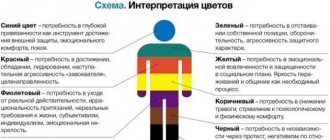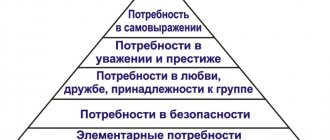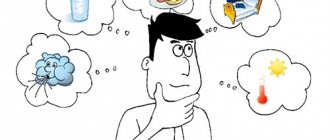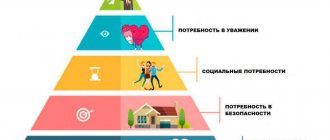What are needs?
Every person has a need to have something. That is, he has a need that requires satisfaction. If he does not get what he wants, he will feel uncomfortable physiologically and psychologically.
If you are hungry, you will not only feel hungry. Thoughts begin to revolve around food, physical and psychological condition worsens, and anger and irritation may appear. But the mood immediately improves after eating. The need is satisfied and life seems much better.
Synonyms for the word “need” are necessity, need, demand. That is, the need represents the demand for objects, functions, people. Unmet needs are internal stimulants of activity. They manifest themselves differently in different situations.
Every person has a certain set of needs. Moreover, the basic needs of all individuals are similar. The difference is only in their strength and quantity.
The number of needs depends on the environment in which a person grew up. If, for example, he was brought up in a family of musicians, then music will be an integral part of his life. If a person grew up in a problematic family, where he was not always well-fed, the most basic needs will be important to him: food, sleep, rest, sex.
When a person feels a need for something, he begins to look for an opportunity to get rid of this need. When he gets what he wants, he experiences satisfaction and pleasure.
Hunger will force you to go to a store or cafe and buy food. But now the need is satisfied, and you already want something completely different, for example, to take a nap. Afterwards, the need will arise to chat with friends, do something creative, etc. There will be no end to the needs. They appear in a newborn baby and end only at the moment of death.
Achieving the goal in stages
A person sets a goal and strives to achieve it by implementing a life plan.
For this:
- a specific desire is indicated;
- a search is underway for methods and tools to meet the need;
- an item is acquired, mastered, used;
- activity is extinguished.
When a personality develops, the structure of its external and internal aspirations for the acquisition is gradually formed:
- self-preservation, nutrition, rest, sexual satisfaction;
- apartments, clothes, household items;
- communication, position, specialty, education;
- happiness, spiritual beauty, goodness.
Each individual prioritizes necessary items in his own way, which are difficult to change in adulthood.
Types of human needs
Needs can be divided into two types: innate and acquired.
Innate are those with which a person came into this world. The baby cannot do without food, water, air. He needs to feel that his mother is nearby and takes care of him. It is necessary that the room is warm, otherwise it will freeze. Even an adult cannot live without basic needs. He also needs to eat, sleep, and breathe.
Acquired are those that appeared as a result of interaction with the social environment. For example, they will be different if a person grew up in a poor and rich family. Some will be happy if they are given sausage sandwiches for breakfast instead of oatmeal, while others will be offended if they are given a two-room apartment instead of a townhouse. If suddenly the realities of life change, and a person accustomed to luxury is left without the usual big money, then he will experience severe discomfort, even if he has the opportunity to satisfy basic needs.
Characteristics of needs
Needs have a number of characteristics and are subject to certain laws:
- At birth, a person is characterized only by physiological needs, the rest develop later.
- The lower needs are characteristic of all people equally.
- The higher ones differ greatly from person to person and form an individual portrait of the individual.
- Satisfaction of lower needs opens the possibility for the formation of higher ones, but does not guarantee it.
- The higher the need, the less important it is for survival and the longer it may remain unsatisfied.
- The more a person is involved in various activities, the more complex his system of needs.
- Suppression has a negative impact on psychological and physiological well-being and deforms the personality.
- The occurrence and satisfaction are associated with various emotions.
- A person's focus is fixed on the subject of need and causes attention to flow in its direction.
More than 100 cool lessons, tests and exercises for brain development
Start developing
Human needs and psychology
If needs exist, then they must be satisfied, and for this purpose purposeful actions must be taken. When a person has a need, he directs his strength to satisfy it. If you want to eat, you buy groceries and prepare some kind of dish. There is a desire to start a family - he is looking for a partner.
But, unfortunately, a person is not always able to satisfy his desires. Moreover, he cannot always understand what exactly he wants. But his peace of mind and happiness depend on this. Therefore, psychology pays a lot of attention to the study of people's needs. Psychologists have noticed several interesting features regarding needs and their satisfaction.
A person is not always aware of his needs. Sometimes people don't understand what they really want. This gives rise to mental suffering, which often turns into psychosomatic illnesses.
Desire and attraction
If a person does not realize what he is drawn to, psychologists use the term “attraction.” That is, he cannot achieve a comfortable state because he is tormented by a need that he does not realize and does not understand. When he begins to understand what he really needs, it is called desire. When desire arises, motivation arises.
Motives, goals, needs
What is motivation? This is a person's movement towards a goal. He has realized what he wants and strives for it; he has a motive. For example, a girl has a goal - losing weight. She begins to take certain actions: goes on a diet, runs in the morning, etc. She has a motive - so that guys pay more attention to her. Then she will begin to feel in demand, that is, she will realize her need.
Needs and emotions
Strong needs lead to strong emotions. If a person experiences strong irritation, it means that some of his needs are not satisfied, and he craves to get something. Therefore, it is important to understand what exactly you want: a good husband, fame, money, there is a desire to buy a big house or go to Paris. In principle, nothing is impossible. The main thing is to understand what you really want. Maybe just to get the attention of a nice neighbor.
What need centers influence a person’s temperament?
These centers can run programs of so-called active-defensive behavior or passive-defensive behavior. And active defensive behavior is when we bravely attack the source of danger and try to figure it out and stop some unpleasant impact. Accordingly, this is also called reactions of aggression, rage, that is, these are reactions that are really aimed at a very active impact on the world around us. And the alternative answer is the reactions of fear, hiding, and running away. They are called passive-defensive, when we strive to somehow avoid contact with the source of trouble.
As a rule, throughout life, as behavior progresses, the brain first prefers passive-defensive reactions. And if they are already driven into a corner, then active defensive reactions are chosen. And how easily the transition from passive-defensive behavior to active-defensive behavior occurs is a very important property of our temperament. Since the time of Hippocrates, the melancholic temperament and the choleric temperament have been particularly distinguished.
The third group of programs that Simonov classified as vital are homeostatic programs. The term “homeostasis” means the constancy of the internal environment of our body. And in order for our organs and tissues to function normally, many parameters need to remain fairly constant. This includes blood temperature, the concentration of various chemicals, blood pressure, and so on. And this is monitored by special neural circuits that are very widely scattered throughout our brain. There are a lot of them inside the medulla oblongata, the pons. The respiratory center is located there. Breathing is also a homeostatic program.
There are vasomotor centers that are responsible for vascular tone and the intensity of heart contractions. It is obvious how vital these programs are. By the way, this same group of programs includes those neural circuits that are responsible for our sleep and wakefulness. Indeed, sleep disorders are very dangerous, and it is obvious that this group of programs belongs to the vital ones.
And two more programs should be mentioned - these are grooming programs and energy saving programs. Simonov also classified them as vital. Energy saving programs are aimed at ensuring that our body spends as little energy as possible to achieve a goal. From a biological point of view, the benefits of these programs are obvious, because in order to obtain energy, you need to eat someone, catch someone, and also spend a lot of energy on this. And besides, it can be fraught with danger. Therefore, the brain is designed in such a way that in order to achieve a goal, it sometimes tends to choose the shortest and most obvious, easiest paths.
And it turns out that, for example, human laziness does not arise just like that, but it is based on such programs for saving energy. Here you also need to understand that our brain is an arena of constant competition between centers of different needs. And if specifically in your brain these centers associated with saving energy are very actively installed, then you will indeed be a somewhat lazy person. True, there remains the mind, a strong-willed effort that can still tear you away from the sofa and move you somewhere into a bright future.
Grooming programs are programs related to body care, that is, washing, licking, combing. They also relate to vital programs, needs, reactions. If you do not do this, then after a while you will be covered with dirt, parasites and die in terrible agony. That is, it is clear that this program is not as vital as, say, breathing, but it is also impossible without it.
Simonov classified zoosocial programs as programs that regulate the intraspecific interaction of individuals. These are programs of sexual behavior, parental behavior, these are programs directed from the cub to the mother, and a whole series of more subtle programs associated mainly with a gregarious way of life, for example, the desire for leadership in a certain community, as well as programs of territorial behavior, programs aimed to occupy and defend a certain territory.
The centers of sexual and parental behavior have been the most studied. They are located in the anterior hypothalamus and are very sensitive to the hormonal status of our body. Sexual behavior programs are activated when the concentration of sex hormones, androgens, and estrogens is high. Active implementation of parental behavior programs is associated with the content of substances such as prolactin and oxytocin in the blood and brain.
The basal ganglia work mainly with territorial behavior programs and programs associated with the desire for leadership. Inside the basal ganglia, or more precisely, inside the temporal lobes of our brain, there is a structure called the amygdala. The amygdala is located inside the temporal lobes of the cerebral hemispheres. That is, if you dissect the temporal lobes, then there will be a small but very significant accumulation of gray matter, so round - hence the name “amygdala”. This should not be confused with the tonsil, which is in the throat. This is a special part of the basal ganglia.
Finally, Simonov classified the so-called empathy reactions as zoosocial programs, when an animal or a person transfers to themselves the emotions experienced by, say, a packmate or another individual. Much later, already in the 2000s, it was shown that so-called mirror neurons are responsible for this kind of reaction. The discovery of mirror neurons is one of the most interesting discoveries in modern physiology.
Maslow's pyramid of needs
Many scientists and researchers have resorted to classification of needs. But Abraham Maslow achieved the greatest success. He was able to distribute all the needs into seven levels, from the lowest (basic) to the highest.
The advantage of this classification of human needs is as follows. A person must go through the lower levels in order for him to develop needs for the higher ones. If they are not satisfied or partially satisfied, he will never reach level 6 or 7, and he will not have other needs.
What kind of pyramid is this?
- It is based on physiological needs : food, sleep, sex, etc. In order to live normally and feel good, a person must eat, breathe, sleep, etc. normally.
- At the second stage is safety . A person has a need for security and comfort. For example, if a person is driven by hunger, then he may commit a crime - robbery, theft. He doesn’t care about the second stage, that is, security. If basic needs are satisfied, he will think more about his safety and not about food.
- At the third stage are social needs. When basic needs are satisfied, the individual feels safe, begins to build social connections, works with someone, takes care of someone.
- The fourth is the need for recognition and prestige. That is, a person wants to have weight in society, respect from other people, achieve certain results in order to be highly appreciated by people.
- The fifth stage is spiritual needs. If a person has satisfied previous needs, he is able to reveal his creative potential, understand himself and identify.
But there are two more levels that Maslow added later. So now the pyramid looks something like this.
- The first stage is physiological needs.
- The second stage is the need for security.
- The third stage is the need for love, in order to love oneself and be loved.
- The fourth stage is the need for respect and recognition in society.
- The fifth stage is the need for knowledge and obtaining new information.
- The sixth stage is aesthetic needs, the search for harmony and beauty.
- The seventh stage is the need for self-actualization, when it is important for a person to realize his ideas and answer the question: who am I and why do I live?
Theories of needs in psychology
Let's look at several theories of famous psychologists who studied this phenomenon.
Abraham Maslow's theory
The most famous theory of the formation and development of needs belongs to the American psychologist, founder of humanistic psychology A. Maslow. According to it, human needs form a clear hierarchical structure consisting of 5 elements. The author himself depicted this structure in the form of a pyramid divided into horizontal sectors.
At the base of the pyramid are needs, the satisfaction of which is vital for a person. The higher the level, the less significant and critical they are. Let's take a closer look at the structure, starting from the bottom level:
- Physiological needs. This includes the need for food, water, natural needs, sleep, and satisfaction of sexual desires. They ensure the normal functioning of the individual at the biological level.
- Safety. This is the need for stability, confidence in the future, maintaining health, etc.
- Socialization and love. It is important for a person to feel that he belongs to society and to establish social connections. This includes the need for attention, affection, and communication.
- Confession. The desire to achieve respect in society and satisfy vain ambitions.
- Self-actualization. The desire to realize the potential inherent in a person to 100%.
The first two levels contain the lowest needs. They are innate and must be satisfied first. The three upper levels contain the so-called higher needs, formed under the influence of the social environment.
Unsatisfied lower levels block the emergence of higher ones. A person must move from the bottom up the pyramid and strive to reach the highest level.
It is the hierarchy of Maslow's theory that is most often criticized. There are many examples that contradict it. For example, how to explain the exploits of soldiers who fought in the name of the Motherland, being hungry or deprived of basic amenities. But nevertheless, at the moment this is the most perfect and advanced theory.
We have a separate article on Maslow’s pyramid on our blog. Take a look there.
Clayton Alderfer's theory
American psychologist Clayton Alderfer slightly modified A. Maslow’s theory, identifying 3 groups:
- Existence needs. The first two stages of Maslow's pyramid are combined here. Alderfer considered them needs of the same order.
- Communication needs. What in Maslow's theory is called the need for socialization and love.
- Growth needs. Learning and striving for inner progress.
Unlike Maslow, Alderfer did not believe that a person moves strictly from lower to higher needs. The dynamics of movement may vary depending on the circumstances.
Take a look at our article about what self-realization is.
David McClelland's theory
American psychologist David McClelland focused his attention on higher needs. He studied the motives that make a person develop in various activities and strive to dominate other people.
McClelland identified three basic needs that develop in a person throughout life:
- In achieving or accomplishing.
- In interaction.
- In power.
However, there is no clear hierarchy between them. Different people may have different needs overriding them. This is determined by individual characteristics and parenting style in childhood.
Erich Fromm's theory
The representative of neo-Freudianism, Erich Fromm, studied the role of the unconscious in the process of formation of needs.
According to his concept, the entire experience of humanity is imprinted in the unconscious, as well as the hidden potential of the individual, which was initially allocated to a person. However, when faced with rigid boundaries and stereotypes of the real world, an internal conflict arises. So many needs remain unfulfilled.
Fromm identified the following needs:
- communication and establishing social connections;
- creation;
- belonging to a clan, a sense of deep roots;
- identification with someone or something;
- cognition.
Other classifications of human needs
It is interesting that throughout human history, philosophers and scientists have put forward different classifications of needs .
So the ancient Greek philosopher Epicurus divides them into three types:
- Needs without which it is impossible to live, calling them natural and obligatory .
- Needs are natural, but optional . For example, if a family of five is huddled in a one-room apartment, it has a need to expand its housing, but in essence it is able to survive in such conditions.
- Needs are unnatural and optional . In this case, whims that are not natural can be considered. For example, “I want to live in the forest, away from everyone,” “I want a horse to become my husband,” etc.
Another interesting classification of needs belongs to psychoanalyst Erich Fromm.
- He put love and friendship , regarding them as the main ones that a person needs.
- In second place is self-affirmation and a sense of self-worth .
- The third is the need to belong to any social group, religion, or culture.
- Fourth place according to Fromm is occupied by creativity and a person’s desire to create something .
- And finally, fifth - knowledge of the world that surrounds a person.
What needs does a person have?
Man is one of the representatives of the animal world, with instincts and needs inherent in other species. At the same time, we have higher intelligence, feelings, and strong-willed qualities. This combination causes the presence of needs at two levels: basic and additional (primary and secondary).
Basic Needs
This group is vital for humans as a biological species. Basic needs are divided into two groups.
| Physiological | Existential |
| Breathing, nutrition, thirst, sleep, rest, procreation, housing. | Comfort, social and legal security, availability of employment, etc. |
Physiological basic needs must be satisfied first, since without them existence itself is impossible. The listed things and phenomena have been inherent in man since primitive times.
A person tries to make the process of satisfying basic needs more comfortable. If at the initial stage of the development of the human race animal skins served as clothing, today a whole industry is working to clothe us.
Basic needs can change with age in favor of the predominance of some over others. Sleep, for example, is more important for young children and older people, but in our youth we are able to get by with minimal hours of rest and still feel alert. Sex, as a primary need, can also, for a number of reasons, lose priority with age, but in adolescence it is a priority.
Questions often arise about security as a necessity for existence. Man has always experienced danger from phenomena in the surrounding world or from other people. A tsunami, a collapse of glaciers, an attack by wild animals or other tribes - all this forced a person to defend himself or run away. Over time, entire institutions were formed that were supposed to protect the individual from external incursions (army, police, Ministry of Emergency Situations). That is why safety is a primary need; we must understand that our lives and property are protected and protected.
The needs of existence (existence) appear as an individual grows up and determines his place in society.
Secondary needs
If a group of primary needs is necessary for survival and is laid down at the genetic level, then secondary needs determine a certain level of a person’s quality of life and come and are transformed with life experience.
Among the secondary needs in theory, the following are identified:
- Spiritual
. These include the need to obtain new knowledge about the world, the search for the meaning of life and one’s place in it, the development of creative abilities, and the desire for harmony. - Social
– love, friendship, interaction with other people, feeling part of society, a separate social group (class, work team, family). - Prestigious
. We are talking about the need for recognition of our successes, worthy self-esteem, respect from other members of the communities in which we belong.
Thus, primary needs are innate and determined by physiology, while secondary needs are psychological in nature and develop throughout life.
Material and intangible goods and services.
Human needs according to Maslow
Each person has his own needs , some of them are similar, for example, the need for food, air and water, and some are different. Abraham Maslow spoke about the needs in the most detailed and accessible way. An American psychologist proposed a theory according to which all human needs can be divided into separate groups located in a certain hierarchy. To move to the next level, a person must satisfy the needs of the lower level. By the way, there is a version that Maslow’s hierarchical theory of needs appeared thanks to the psychologist’s study of the biographies of successful people and the found pattern of existing desires.
Maslow's Hierarchy of Human Needs
The levels of human needs are presented in the form of a pyramid. Needs constantly replace each other, taking into account their significance, so if a person has not satisfied the primitive needs, then he will not be able to move on to other stages.
Types of needs according to Maslow:
1. Level No. 1 – physiological needs. The base of the pyramid, which includes the needs that all people have. You need to satisfy them in order to live, but it is impossible to do this once and for the rest of your life. This category includes the need for food, water, shelter, etc. To satisfy these needs, a person takes active action and begins to work.
2. Level No. 2 – need for security. People strive for stability and security. Satisfying this need according to Maslow’s hierarchy, a person wants to create comfortable conditions for himself and his loved ones, where he can hide from adversity and problems.
3. Level No. 3 – need for love. People need to feel important to others, which manifests itself both on a social and spiritual level. That is why a person strives to start a family, find friends, become part of a team at work and join other groups of people.
4. Level No. 4 – the need for respect. People who have reached this period have the desire to become successful, achieve certain goals and gain status and prestige. To do this, a person learns, develops, works on himself, makes important contacts, etc. The need for self-esteem implies the formation of personality.
5. Level No. 5 – cognitive abilities. People strive to absorb information, learn, and then apply the acquired knowledge in practice. For this purpose, a person also reads, watches educational programs, and, in general, receives information in all existing ways. This is one of the basic human needs according to Maslow, since it allows you to quickly cope with different situations and adapt to life circumstances.
6. Level No. 6 – aesthetic needs. This includes a person’s aspirations for beauty and harmony. People use their imagination, artistic taste and desire to make the world more beautiful. There are people whose aesthetic needs are more important than physiological ones, so for the sake of ideals they can endure a lot and even die.
7. Level No. 7 – the need for self-actualization. The highest level that not all people reach. This need is based on the desire to achieve set goals, develop spiritually, and also on the use of one’s abilities and talents. A person lives with the motto - “only forward.”
Maslow's theory of human needs has its shortcomings. Many modern scientists argue that such a hierarchy cannot be taken as truth, since there are many shortcomings. For example, a person who decides to fast is contrary to the concept. In addition, there is no tool that would allow us to measure the strength of each person's needs.
Needs and requirements
Needs and wants—these two most important concepts of marketing are best considered together, in comparison, so it will be clearer.
Needs are understood as those without which a person cannot exist. Needs are sometimes called the physiological needs of people. But, perhaps, a more accurate, and therefore more acceptable designation of that without which a person cannot live, is precisely the term need.
Need should also be understood as a need , only conditioned by the level of development of the culture of a given society and the personality of the consumer.
Let us supplement this definition of need with the fact that it as a need can be determined not only by the level of culture, but also by the levels of development of science, technology and technology
Well, what is the difference between needs and wants , a question may arise, if a need is also a need, only conditioned by the level of development of certain factors? And is there really this difference at all? Perhaps the differences in their definitions are far-fetched? There is a difference between these concepts, and a very big one. The entire philosophy of marketing (and, perhaps, entrepreneurship in general) is based on this difference. The essence of this difference is that needs exist objectively, they do not depend on the will and consciousness of people and are not created by people. Needs are subjective - they are created by people .
One day, TV journalist Yu.A. Sienkiewicz, in the popular program Film Travel Club, showed a tribe of people that modern American researchers found in the Amazon jungle and which developed in isolation from the world. They still don't cook their food over fire, and what they eat still moves. Let us now assume that the researchers who found these people taught them to cook over fire. And such food seemed better to them, tastier than traditional food, and now they don’t want to put any other food in their mouth. What happened in this primitive society? They still had and still have needs for food consumption. New needs have emerged. From this we can conclude that subjective needs in society take the form of objective objects that can satisfy objective needs.
Yes, indeed, needs, by and large, are not created by people (people are born with them). Needs are always created .
Requests
Requests represent the same needs, but limited by available resources . In other words, if the buyer is able to pay for the fulfillment of his needs, they inevitably become requests.
It would seem that, knowing the resources of certain communities of people, studying their annual requests, one can annually plan the production of goods for these communities . This is how it was in our planned economic system. At the same time, they completely did not take into account the fact that the objectively determined need of any person is his desire for variety in consumption. A deep understanding of the needs, demands and demands of its customers (clients) allows the company to formulate and justify the right marketing strategy for its development. The needs and requirements of the market are studied in order to improve the product, create its new models, and requests - in order to plan production volumes.
Goods and services
By goods we should understand everything that is produced for sale, has the ability to satisfy very specific needs and requirements and is offered to people for exchange and subsequent consumption. Any product, therefore, has certain consumer properties. If a family plants potatoes on their plot in the spring only in order to consume them as food within their family in the winter, then these potatoes should be classified as a product, but not a commodity. If planting is carried out not only for the purpose of consumption by the producers themselves, but also for sale, then that part of it that is produced specifically for sale is, of course, a commodity. There is no need to prove the presence of the consumer properties of potatoes here - they are obvious.
Goods should include not only material objects. Services and various types of information can also be goods . A trip to a sanatorium, a fashionable hairstyle, a mathematical model for optimizing a production program, a method for calculating and systematically justifying labor standards - if someone has needs for them, and also if they are produced to satisfy them, then these services and information are certainly goods.
Of course, a service as a product is noticeably different from a product that has a physical embodiment. Let’s say watching a performance in a theater—both action and consumption occur simultaneously. A physical product, if you do not like it or does not meet the declared requirements, can always be returned to the manufacturer (or intermediary) in exchange for the money paid. The service cannot be returned so easily.
Of course, the situation is somewhat simpler when providing services that
do not require mutual contact between the parties, for example, repair services. The sale of such services is similar to the sale of physical goods. There are other types and varieties of services that have characteristics of those that require mandatory contact between the parties , and those for which such contact is not required. Let's say lunch at a restaurant.
A restaurant visitor has contact with the waiter, and he consumes the service in his visible or invisible presence, while at the same time, while consuming dishes, he does not come into contact with the cook who prepared them. But the result of the contact between the visitor and the waiter, which is so important for the entire restaurant, largely depends on the skill of the cook. (In Japan, there are restaurants in which the chef prepares the ordered dish in the presence of the visitor - here the contact between the visitor and the cook is obvious.)
Thus, the world of services is no less diverse than the world of physical goods. And working in the market for certain services is not easy. Therefore, the marketing of services should perhaps be more accurate and balanced than the marketing of physical goods, because many inaccuracies in the behavior of the service provider cannot always be corrected.
Quite often, the sale of a physical product is accompanied by or involves the subsequent provision of certain services to the buyer. Thus, buying a car inevitably entails the need for servicing. And it will be good if the company ensures the relationship and interdependence between the provision of services and product improvement.
Exchange
Exchange is the next working concept of marketing. Exchange is the process of transferring goods into the ownership of another person. Exchange is one of the four ways a person can acquire the desired thing.
What other ones are there? These include self-sufficiency, theft (robbery) and begging (solicitation of sponsorship should also perhaps be classified in this category).
Self-sufficiency in a number of products is difficult to achieve.
And theft and begging are generally disgusting to the human race, although they are both quite common.
So it turns out that the only acceptable way for a person to acquire the desired thing is exchange, in modern society - the exchange of products of the activity of each individual participating in the exchange process through money.
Five conditions , without meeting at least one of them, exchange becomes impossible:
1) there must be at least two parties;
2) each party must have a certain value for the other;
3) each party must have the ability to communicate and deliver goods;
4) each party must be free to accept or reject the other party's proposals;
5) each party must be confident in its benefits from the exchange with the other party.
Deal and relationship
A transaction should be understood as an agreement regarding an exchange, which stipulates the conditions that satisfy all parties to the transaction (the value of the objects of exchange, the agreed conditions for its implementation, the time and place of completion, etc.). These conditions only create the preconditions for exchange. Whether it actually takes place or not is determined by whether the parties come to an agreement on the exchange.
If an agreement is reached, then the act of exchange improves the situation of both parties. And in this sense, exchange, just like production, creates value.
Thus, depending on the goals of the seller, marketing itself can be divided into two types:
1. transaction-oriented marketing;
2. relationship-oriented marketing.
Transaction-oriented marketing presupposes a basic one-time sale as its main goal.
Relationship marketing pursues deeper and longer-term goals, namely the establishment of close business relationships in which the exchange acts will be ongoing. It is clear that a skilled marketing function must develop relationship-oriented marketing.
Material and intangible goods and services.
In all developed countries, the economy consists of two interconnected and complementary spheres of production aimed at obtaining benefits:
• material, where a product is created in material form, for example, shoes, machines, cement, coal;
• intangible , where spiritual, moral and other values are created - works of culture, art, science, etc.
Benefits are means of satisfying people's needs.
There are many criteria on the basis of which different types of benefits are distinguished (Fig. 2.2). Benefits can be classified into:
1) material, including natural gifts of nature (land, air, water, climate); production products (food, buildings, structures, machines, tools);
2) intangible, having the form of activity useful to people and affecting the development of human abilities. They are created in the non-productive sphere: healthcare, education, culture, etc. These include internal benefits given to man by nature - abilities in science, voice, ear for music, etc., as well as external benefits - what the outside world gives for satisfaction of needs (reputation, business connections, patronage, etc.).
Human life activity in the process of managing is manifested, on the one hand, in the waste of energy, resources, etc., and on the other, in the corresponding replenishment of living expenses. At the same time, an economic subject (i.e. a person in economic activity) strives to act rationally - by comparing costs and benefits. This behavior is explained as follows.
An essential feature of human life and activity is dependence on the material world. Some material goods are available in abundance and therefore they are always available to people (air, sun rays, wind energy). Such goods in economic theory are called free or non-economic. As long as these conditions remain, these goods and the needs for them are not human concerns and calculations, therefore, they are not studied in economics.
Other material goods are available in limited quantities (various kinds of “rarities”). In order to satisfy the needs for them and to have them in an accessible quantity, human efforts are necessary to obtain them and adapt to the needs.
These benefits are called economic (or economic). The well-being of people depends on the possession of these goods, so they handle them carefully, economically, and prudently.
A specific form of economic good is goods, i.e. labor products created for exchange (sale).
Until now we have been talking only about goods, but the production process also includes the provision of services.
Services are human economic activities, the results of which are expressed in meeting the personal needs of the population and society as a whole.
There are tangible and intangible services. The first type includes transport, storage, utilities, postal and other services, the second - the services of lawyers, police officers, university teachers, artists, etc.
The latest ideas about the structure of highly developed production are schematically summarized in Fig. 2.3.
A specific form of economic good is a commodity, i.e. a good produced for exchange. We will give a more detailed description of the product in Chapter 5. Now it is important to find out that in the process of human economic activity, goods and services are produced that satisfy certain needs of people. If there is no need for the produced product (service), there is no one willing to purchase it, there will be no market for it and the manufacturer will not receive any benefit from its production. As a result, such a product will not be produced.










